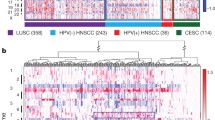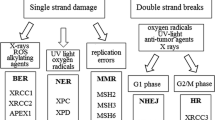Abstract
Head and neck squamous cell carcinomas (HNSCC) arise as a consequence of cumulative genetic changes brought about by continued exposure to carcinogens associated with tobacco and alcohol use, influenced by viral agents such as human papillomaviruses, in a background of acquired or heritable genetic susceptibility. The presence of widespread genomic instability in HNSCC, such as cytogenetic aberrations, allelic imbalance/loss of heterozygosity, and microsatellite instability, suggests that there is an imperfection in the host DNA repair machinery. Genomic instability with progressive accumulation of detrimental genetic alterations appears to be dependent upon a circuitous interaction between the environmental genotoxic insults and the host DNA repair machinery, the functional integrity of which is governed by the proper cell cycle control and host DNA repair capacity. Thus, it can be hypothesized that continued exposure to environmental carcinogens (ie, longstanding history of smoking and drinking), loss of proper cell cycle control (eg, inactivation of p53 or p16 tumor suppressor genes or amplification of the proto-oncongene cyclin D1), and impaired DNA repair capacity (both inherited and acquired) are prerequisites in head and neck carcinogenesis.
Similar content being viewed by others
References
Parker SL, Tong T, Bolden S, et al.: Cancer statistics, 1996. CA Cancer J Clin 1996, 46:5–27.
Scully C, Field JK, Tanzawa H: Genetic aberrations in oral or head and neck squamous cell carcinoma (SCCHN): 1. Carcinogen metabolism, DNA repair and cell cycle control. Oral Oncol 2000, 36:256–263. A comprehensive review on genes involved in tumor susceptibility and DNA repair in HNSCC.
Paz IB, Cook N, Odom-Maryon T, et al.: Human papillomavirus (HPV) in head and neck cancer: an association of HPV 16 with squamous cell carcinoma of Waldeyer’s tonsilar ring. Cancer 1997, 79:595–604.
Landis SH, Murray T, Bolden S, et al.: Cancer statistics. CA Cancer J Clin 1998, 48:6–29.
Gallo O, Chiarelli I, Boddi V, et al.: Cumulative prognostic value of p53 mutations and bcl-2 protein expression in head and neck cancer treated by radiotherapy. Int J Cancer 1999, 84:573–579.
Bradford CR, Zhu S, Poore J, et al.: p53 mutation as a prognostic marker in advanced laryngeal carcinoma: Department of Veterans Affairs Laryngeal Cancer Cooperative Study Group. Arch Otolaryngol Head Neck Surg 1997, 123:605–609.
Olshan AF, Weissler MC, Pei H, et al.: Alterations of the p16 gene in head and neck cancer: frequency and association with p53, PRAD-1 and HPV. Oncogene 1997, 14:811–818.
Haraf DJ, Nodzenski E, Brachman D, et al.: Human papilloma virus and p53 in head and neck cancer: clinical correlates and survival. Clin Cancer Res 1996, 2:755–762.
Ahomadegbe JC, Barrois M, Foget S, et al.: High incidence of p53 alterations (mutation, deletion, overexpression) in head and neck primary tumors and metastases; absence of correlation with clinical outcome: frequent protein overexpression in normal epithelium and in early non-invasive lesions. Oncogene 1995, 10:1217–1227.
Sauter ER, Ridge JA, Litwin S, et al.: Pretreatment p53 protein expression correlates with decreased survival in patients with end-stage head and neck cancer. Clin Cancer Res 1995, 11:1407–1412.
Sidransky D, Hollstein M: Clinical implications of the p53 gene. Ann Rev Med 1996, 47:285–301.
Eisenstadt E, Warren AJ, Porter J, et al.: Carcinogenic epoxides of benzo[a]pyrene and cyclopenta[cd]pyrene induce base substitutions via specific transversions. Proc Natl Acad Sci U S A 1982, 79:1945–1949.
Saffhill R, Margison GP, O’Connor PJ: Mechanisms of carcinogenesis induced by alkylating agents. Biochim Biophy Acta 1985, 823:115–145.
Cheng KC, Cahill DS, Kasai H, et al.: 8-Hydroxyguanine, an abundant form of oxidative DNA damage, causes G—T and A—C substitutions. J Biol Chem 1992, 267:166–172.
Ganly I, Soutar DS, Brown R, et al.: p53 alterations in recurrent squamous cell cancer of the head and neck refractory to radiotherapy. Br J Cancer 2000, 82:392–398.
Gallo O, Bianchi S, Giovannucci-Uzzielli ML, et al.: p53 oncoprotein overexpression correlates with mutagen-induced chromosome fragility in head and neck cancer patients with multiple malignancies. Br J Cancer 1995, 71:1008–1012.
Baas IO, Mulder JR, Offerhaus GJA, et al.: An evaluation of six antibodies for immunohistochemistry of mutant p53 gene product in archival colorectal neoplasms. J Pathol 1994, 172:5–12.
Califano J, Westra WH, Meininger G, et al.: Genetic progression and clonal relationship of recurrent premalignant head and neck lesions. Clin Cancer Res 2000, 6:347–352.
Califano J, van der Riet P, Westra W, et al.: Genetic progression model for head and neck cancer: implications for field cancerization. Cancer Res 1996, 56:2488–2492.
Hegde PU, Brenski AC, Caldarelli DD, et al.: Tumor angiogenesis and p53 mutations. Arch Otolaryngol Head Neck Surg 1998, 124:80–85.
Shiga H, Heath EI, Rasmussen AA, et al.: Prognostic value of p53, glutathione S-transferase, and thymidylate synthase for neoadjuvant cisplatin-based chemotherapy in head and neck cancer. Clin Cancer Res 1999, 5:4097–4104.
Warnakulasuriya S, Jia C, Johnson N, et al.: p53 and P-glycoprotein expression are significant prognostic markers in advanced head and neck cancer treated with chemo/ radiotherapy. J Pathol 2000, 191:33–38.
Field JK, Malliri A, Butt SA, et al.: p53 over-expression in end stage squamous cell carcinomas of the head and neck: correlates with a very poor clinical outcome. Int J Oncol 1993, 3:431–435.
McKaig RG, Baric RS, Olshan AF: Human papillomavirus and head and neck cancer: epidemiology and molecular biology. Head Neck 1998, 20:250–265.
Schartz SM, Daling JR, Doody DR, et al.: Oral cancer risk in relation to sexual history and evidence of human papillomavirus infection. J Natl Cancer Inst 1998, 90:1626–1636.
Smith EM, Hoffman HT, Summersgill KS, et al.: Human papillomavirus and risk of oral cancer. Laryngoscope 1998, 108:1098–1103.
Gillison ML, Koch WM, Capone RB, et al.: Evidence for a causal association between human papillomavirus and a subset of head and neck cancers. J Natl Cancer Inst 2000, 92:709–720. Report from the most comprehensive study on HPV infection in HNSCC, suggesting that HPV-positive tonsilar carcinomas may represent a distinct clinicopathologic entity with improved survival.
Andl T, Kahn T, Pfuhl A, et al.: Etiological involvement of oncogenic human papillomavirus in tonsilar squamous cell carcinomas lacking retinoblastoma cell cycle control. Cancer Res 1998, 58:5–13.
Wilczynski SP, Lin BTY, Wie Y, et al.: Detection of human papillomavirus DNA and oncoprotein overexpression are associated with distinct morphological patterns of tonsilar squamous cell carcinoma. Am J Pathol 1998, 152:145–156.
Fouret P, Monceaux G, Temam S, et al.: Human papillomavirus in head and neck squamous cell carcinomas in nonsmokers. Otolaryngol Head Neck Surg 1997, 123:513–516.
Jin YS, Heim S, Mandahl N, et al.: Unrelated chromosomal aberrations in carcinomas of the oral cavity. Genes Chromosomes Cancer 1990, 1:209–215.
Field JK: Genomic instability in squamous cell carcinoma of the head and neck. Anticancer Res 1996, 16:2421–2432.
Arzimanoglou II, Gilbert F, Barber HR: Microsatellite instability in human solid tumors [review]. Cancer 1998, 82:1808–1820.
Cheng L, Eicher SA, Guo Z, et al.: Reduced DNA repair capacity in head and neck cancer patients. Cancer Epidemiol Biomarkers Prev 1998, 7:465–468. This population-based case-control study established a correlation between reduced DNA repair capacity and increased head and neck cancer risk.
Wang LE, Sturgis EM, Eicher SA, et al.: Mutation sensitivity to benzo(a)pyrene diol epoxide and the risk of squamous cell carcinoma of the head and neck. Clin Cancer Res 1998, 4:1773–1778.
Sturgis EM, Castillo EJ, Li L, et al.: Polymorphisms of DNA repair gene XRCC1 in squamous cell carcinoma of the head and neck. Carcinogenesis 1999, 20:2125–2129.
Wei Q, Eicher SA, Guan Y, et al.: Reduced expression of hMLH1 and hGTBP/hMSH6: a risk factor for head and neck cancer. Cancer Epidemiol Biomarkers Prev 1998, 7:309–314. This population-based case-control study documented a correlation between decreased expression of several mismatch DNA repair genes and increased head and neck cancer risk.
Dizdaroglu M: Chemicaldetection of free radical-induced damage to DNA. Free Radical Biol Med 1991, 10:225–242.
Hollstein M, Sidransky D, Vogelstein B, et al.: p53 mutations in human cancers. Science 1991, 253:49–53.
Blons H, Radicella P, Laccourreye O, et al.: Frequent allelic loss at chromosome 3p distinct from genetic alterations of the 8-oxoguanine DNA glycosylase 1 gene in head and neck cancer. Mol Carcinog 1999, 26:254–260.
Fan CY, Barnes EL, Swalsky PA, et al.: Deficiency of oxidative DNA damage repair due to OGG1 mutation is a common event in malignant transformation of squamous mucosa of the head and neck and is not present in reactive squamous cell hyperplasia. Mod Pathol 2000, 13:137A.
Dhenaut A, Boiteux S, Radicella JP: Genomic structure and promoter characterization of the human 8-OH-guanine glycosylase gene (OGG1) gene. GenBank accession AJ 131341; 1999.
Sanchez-Cespedes M, Esteller M, Wu L, et al.: Gene promoter hypermethylation in tumors and serum of head and neck cancer patients. Cancer Res 2000, 60:892–895. This article describes the presence of promoter hypermethylation in the MGMT gene, a gene responsible for repair of alkylating N-nitroso compound-induced DNA base lesion, indicative of a role of the inactivated DNA repair gene in HNSCC.
Esteller M, Toyota M, Sanchez-Cespedes M, et al.: Inactivation of the DNA repair gene O6-methylguanine-DNA methyltransferase by promoter hypermethylation is associated with G to A mutations in K-ras in colorectal tumorigenesis. Cancer Res 2000, 60:2368–2371. This article provides evidence linking promoter hypermethylation of the MGMT gene and specific mutations in the proto-oncogene, K-ras.
Papadopoulos N, Nicolaides NC, Wei YF, et al.: Mutation of a MutL homolog in hereditary colon cancer. Science 1994, 263:1625–1629.
Wheeler JM, Beck NE, Kim HC, et al.: Mechanisms of inactivation of mismatch repair genes in human colorectal cancer cell lines: the predominant role of hMLH1. Proc Natl Acad Sci U S A 1999, 96:10296–10301.
Suzuki H, Itoh F, Toyota M, et al.: Distinct methylation pattern and microsatellite instability in sporadic gastric cancer. Intl J Cancer 1999, 83:309–313.
Strathdee G, MacKean MJ, Illand M, et al.: A role for methylation of the hMLH1 promoter in loss of hMLH1 expression and drug resistance in ovarian cancer. Oncogene 1999, 18:2335–2341.
Piccinin S, Gasparotto D, Vukosavljevic T, et al.: Microsatellite instability in squamous cell carcinomas of the head and neck related to field cancerization phenomena. Br J Cancer 1998, 78:1147–1151.
Lo Muzio L, Nocini P, Mignogna MD, et al.: Immunocytochemical detection of hMSH2 and hMLH1 expression in oral SCC. Anticancer Res 1999, 19:933–940.
Author information
Authors and Affiliations
Rights and permissions
About this article
Cite this article
Fan, CY. Genetic alterations in head and neck cancer: interactions among environmental carcinogens, cell cycle control, and host DNA repair. Curr Oncol Rep 3, 66–71 (2001). https://doi.org/10.1007/s11912-001-0045-0
Issue Date:
DOI: https://doi.org/10.1007/s11912-001-0045-0




